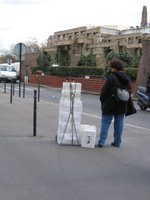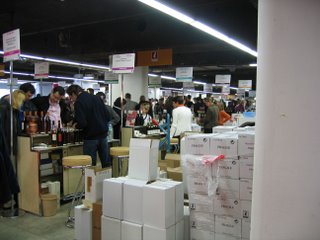 The Paris Wine Exposition was held recently where 500 wineries from all over
The Paris Wine Exposition was held recently where 500 wineries from all over 
We knew we were on the right track when we sortie-d the subway and made our way towards the exhibition hall. It was not uncommon to see people with carts stacked full of cases of wine.
Upon entering we were given a tasting glass (to keep) and ushered in with the masses to make our way through the randomly situated tasting counters. There was no organization by region, which was maddening at first, but understandable in that it encouraged wider sampling. So, it was difficult to keep to any sort of usual "white first, then reds, then sweet wines" order.
As we entered the exhibition hall, we were overwhelmed by the sheer amount of wines. It took a few minutes for us to realize it wasn't worth forming a strategy for attack, but rather necessary to just dive in and start tasting. Most of the people pouring the wines were the actual winery owners or wine makers, which made for many pleasant discussions and an intimate feeling within the general chaos of the crowded hall. Being the wine lovers we are, I went both Friday and Saturday; Paul went Friday, Saturday and Sunday.
 We decided the first day to just try and cover a few aisles. I believe we tackled aisles D through K and were there about 3 hours. Of course, we didn't try every wine but just hit the ones that peeked our interest. Of those, the ones I remember most were wonderful reds from Châteauneuf-du-Pape and Cabardès, a region in Southern of France. We had really friendly conversations with both of the winemakers and a particularly interesting discussion with the woman pouring the Cabardès about American and French winemaking. I loved her immediately. There is definitely the feeling that even though Parker has recognized French wines like Châteauneuf-du-Pape, and is the authority on
We decided the first day to just try and cover a few aisles. I believe we tackled aisles D through K and were there about 3 hours. Of course, we didn't try every wine but just hit the ones that peeked our interest. Of those, the ones I remember most were wonderful reds from Châteauneuf-du-Pape and Cabardès, a region in Southern of France. We had really friendly conversations with both of the winemakers and a particularly interesting discussion with the woman pouring the Cabardès about American and French winemaking. I loved her immediately. There is definitely the feeling that even though Parker has recognized French wines like Châteauneuf-du-Pape, and is the authority on Our favorite wines were a 2004 Domaine des Relagnes from Châteauneuf-du-Pape at 14 €, a deliciously complex, well balanced, and affordable wine when compared to its expensive cousins from that region; it was an exciting find. Our 6 bottles of 2000 Château Bournonville from Cabardès at around 6 € each, a great wine with smoky depth and soft prune flavors. Next was a 2 bottles of 2002 Domaine du Cinquau, a sweet white Jurançon at 8 €; a perfect meal-ender. We were also impressed with a bottle of 2005 Les Porcheronnes, a velvety Pouilly-Fumé at 9 €, and 4 bottles of the cheapest white burgundy in history at 3.50 € from Domaine Gille! We also splurged for the exquisite 2000 Chateau Ripeau, a Grand Cru from Saint-Émilion that was 21 euros. It's a huge, tannic, intense and delicious wine.
 There are a few problems with a huge wine tasting exhibition like this one. With so many wines, it is difficult to corner the best wines since you will most likely wade through more than a few bad ones before finding something exceptional. I found my palate seriously compromised after an hour, even with pouring out most of the wines after one sip. I did see just a few people spitting, but the buckets were placed on the floor, which made it extremely awkward (and decidedly unfeminine) to spit either from a standing distance or bending over to sort of hurl your wine into the bucket. So, we were left with just dumping most of the wine out and being careful with our sips, which gets more and more difficult as you encounter better wines.
There are a few problems with a huge wine tasting exhibition like this one. With so many wines, it is difficult to corner the best wines since you will most likely wade through more than a few bad ones before finding something exceptional. I found my palate seriously compromised after an hour, even with pouring out most of the wines after one sip. I did see just a few people spitting, but the buckets were placed on the floor, which made it extremely awkward (and decidedly unfeminine) to spit either from a standing distance or bending over to sort of hurl your wine into the bucket. So, we were left with just dumping most of the wine out and being careful with our sips, which gets more and more difficult as you encounter better wines.Another issue was switching constantly between styles, colors and regions of wine. I tried at least to avoid sweet wines until towards the end, but even changing regions of reds made it difficult to adjust and evaluate the wines. It was hard to trust my taste buds after awhile. So, all in all, it was a wonderful opportunity to try a lot of wines, but tricky to judge their true quality. Since we have also traveled a lot throughout
Favorite region for whites:
Whether you enjoy dry whites or sweeter ones, you can find everything here. I can't say enough about how delicious these wines can be. I love their character. I enjoy cooking with them, not to mention drinking them. Never being one to prefer sweet wines, I actually find a good quality late harvest
Alsatian winemakers are really proud of how their wines pair with food, and it is something I've learned to recognize more and more. The wines that really interest me now are the ones where I can practically taste the food along with it. That complexity is what gets me. What can I say? I'm a convert.
Favorite region for reds: Impossible to say with so many good ones, but lately Southwestern regions.
Reds are tough in  Worst wines tried (sorry): Jura
Worst wines tried (sorry): Jura
Surprising in that we found it totally imbuvable, undrinkable. We had gotten a few recommendations to try wines from Jura (located just on top of
Coolest Find: Jurançon (Southwest France including Toulouse and Bayonne)
I preferred their sweet whites because they had greater complexity than their dry wines, and given my preference for Alsace, they didn't really stand a chance anyway! But, this being my first time tasting this wine, I was blown away. I read that drops of a Jurançon wine were placed on the lips of Henri IV at his BAPTISM in 1553. There you go. Made of the unheard of Manseng white grape, it tastes like caramelized pinapple to me; really delicious and worth checking out!
There you have it, the Chez Mégane report on the wine tasting. We came home exhausted after two (or three) days of masochistic wine tasting but really pleased with our purchases; our fingers stained purple, our mouths a bit parched and our heads swirling with new found loves.
No comments:
Post a Comment